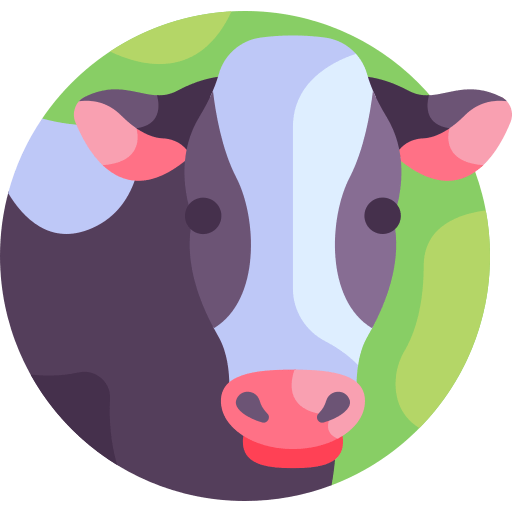Breeds of Beef Cattle Dairy Cattle Breeds
Dairy Cows
Types of Dairy Cows
Dairy cows are bred for their ability to produce milk from which dairy foods are made. While in that location are many different breeds of cows, in the U.Due south., there are seven different dairy cow breeds: Ayrshire, Brown Swiss, Guernsey, Holstein, Bailiwick of jersey, Milking Shorthorn, Red & White. Acquire more than about each breed of dairy cow below!
Learn More About the Breeds of Dairy Cows
Ayrshire
Origin: This breed was brought to America around 1800 from the Scottish canton of Ayr.
Characteristics: Known as the "aristocrat" of dairy breeds because of their size and vigor, they are rusty-red and white in color and arrange easily to their environment.
Fun Fact: Because of their adaptability, Ayrshires are found in near parts of the earth, including Southern Africa.
Brown Swiss
Origin: The Alps of Switzerland.
Characteristics: Considered the oldest of the dairy breeds, Brown Swiss tin vary in colour, from silver to night brown, and are large with large ears. Their milk is ideal for making cheese because of its loftier poly peptide-to-fat ratio.
Fun Fact: In Switzerland, Dark-brown Swiss are taken to high mountain meadows in the summer. They article of clothing large moo-cow bells so farmers can observe them in the fog!
Guernsey
Origin: Start raised by monks on the Isle of Guernsey in the English Channel.
Characteristics: Guernsey cows can range from fawn to golden in colour and often has white legs and white areas on her trunk.
Fun Fact: Known for their rich, golden color of milk, she was given the title "Gilded Guernsey." Their milk color is due to loftier levels of beta carotene (a source of vitamin A) in the milk.
Holstein
Origin: Holland. A Dutch settler brought the commencement Holstein to America in 1631.
Characteristics: This breed is the most common of the dairy breeds, and in addition to her blackness-and-white markings, she produces more milk than other dairy breeds.
Fun Fact: Did you lot know Holstein cows' spots are like snowflakes or fingerprints? No two are exactly alike!
Jersey
Origin: The Island of Jersey in the English language Channel.
Characteristics: The Bailiwick of jersey is the smallest of the dairy breeds and her color ranges from light to night brown. The most heat-tolerant of dairy breeds, she produces milk with a very high butterfat content (perfect for ice cream).
Fun Fact: Borden Dairy introduced the famous Elsie the Cow, a Jersey, in 1936.
Milking Shorthorn
Origin: Northeastern England in the valley of the Tees River, first coming to the U.S. early in the 1780's.
Characteristics: Milking Shorthorns are considered a dual-purpose brood that can be used for milk or beef production. Large in size, they are ofttimes white and roan in color and their milk is known for its high protein-to-fat ratio.
Fun Fact: This brood is part of the foundation for other red types of milk cows, including Swedish Ruby cattle and Illawarra cattle in Commonwealth of australia!
Red & White
Origin: The Netherlands.
Characteristics: With characteristics similar to a blackness-and-white Holstein, the "red" of the Red & White resembles the brown of a chestnut equus caballus. She is known for a strong allowed organization and tolerance to heat.
Fun Fact: This is the about recent breed of cows to exist recognized, coming into the breed family unit in 1964. The expression of the red color is a function of a recessive gene.
Fun Farm Facts
About 95% of U.Due south. dairy farms are family-owned and operated.
Milk from cows is a local food traveling from cows to you in nearly 48 hours.
Cows wear activeness trackers which tin show how much they eat, sleep, and milk. This private intendance helps farmers keep their cows healthy.
Cows rest almost x hours a day. Some lay on comfortable sand, similar a beach!
Farmers work with veterinarians, fauna nutritionists, soil and water conservationists, and even hoof trimmers making sure their cows are cared for.

Dairy Cows and Sustainability
Dairy cows are the ultimate upcyclers! They eat byproducts that humans cannot eat, like sugar beet lurid. Some dairy farmers even partner with local businesses like grocers and stores to feed their cows products these partners are unable to sell, like expired fruit and chocolate. This reduces the food waste going into landfills.
Moo-cow manure can be a source of energy, too! Applied science like methyl hydride digesters tin can convert manure into biogas, a renewable fuel to assist power generators or h2o heaters. Excess biogas can also be sold back to electrical grids. Farmers too apply cow manure to fertilize their crops, which reduces the need for chemical fertilizers and pesticides.
More Resources on Dairy Farming
Source: https://www.midwestdairy.com/sustainability/farm-life/dairy-cows/





0 Response to "Breeds of Beef Cattle Dairy Cattle Breeds"
Postar um comentário